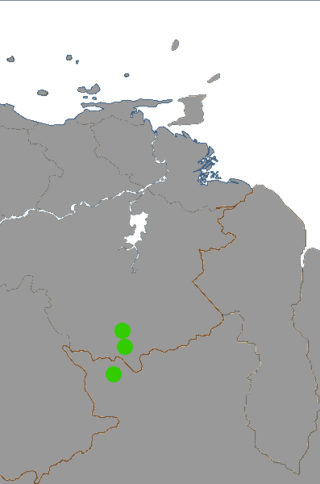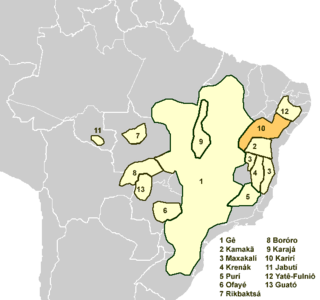Related Research Articles

The Cariban languages are a family of languages indigenous to north-eastern South America. They are widespread across northernmost South America, from the mouth of the Amazon River to the Colombian Andes, and they are also spoken in small pockets of central Brazil. The languages of the Cariban family are relatively closely related. There are about three dozen, but most are spoken only by a few hundred people. Macushi is the only language among them with numerous speakers, estimated at 30,000. The Cariban family is well known among linguists partly because one language in the family—Hixkaryana—has a default word order of object–verb–subject. Prior to their discovery of this, linguists believed that this order did not exist in any spoken natural language.

The Chapacuran languages are a nearly extinct Native American language family of South America. Almost all Chapacuran languages are extinct, and the four that are extant are moribund, with the exception of Wari'. They are spoken in Rondônia in the southern Amazon Basin of Brazil and in northern Bolivia.

Barbacoan is a language family spoken in Colombia and Ecuador.

Mapinguari, or mapinguary, are mythical monstrous jungle-dwelling spirits from Brazilian folklore, said to protect the Amazon rainforest and its animals.

Arawan is a family of languages spoken in western Brazil and Peru (Ucayali).

Yanomaman, also as Yanomam, Yanomáman, Yamomámi, and Yanomamana, is a family of languages spoken by about 20,000 Yanomami people in southern Venezuela and northwestern Brazil.

Tacanan is a family of languages spoken in Bolivia, with Ese’ejja also spoken in Peru. It may be related to the Panoan languages. Many of the languages are endangered.

Arutani–Sape, also known as Awake–Kaliana or Kalianan, is a proposed language family that includes two of the most poorly documented languages in South America, both of which are now extinct. They are at best only distantly related. Kaufman (1990) found a connection convincing, but Migliazza & Campbell (1988) maintained that there is no evidence for linking them. The two languages are,
The Júma are an Indigenous people of Brazil, who live in the Terra Indígena Juma in the Amazonas, along the Mucuim River, a tributary of Rio Açuã.
Ticuna–Yuri is a small family, perhaps even a dialect continuum, consisting of at least two, and perhaps three, known languages of South America: the major western Amazonian language Ticuna, the poorly attested and extinct Yurí, and the scarcely known language of the largely uncontacted Carabayo. Kaufman also adds Munichi to the family.
Saparo–Yawan is a language family proposal uniting two small language families of the western Amazon. It was first proposed by Swadesh (1954), and continues through Payne (1984) and Kaufman (1994).
Witotoan is a small language family of southeastern Colombia and the neighbouring region of Peru.

The Karirí languages, generally considered dialects of a single language, were a group of languages formerly spoken by the Kiriri people of Brazil. It was spoken until the middle of the 20th century; the 4,000 ethnic Kiriri are now monolingual Portuguese speakers, though a few know common phrases and names of medicinal plants.
Katembri–Taruma is a language family proposed by Kaufman (1990) that links two extinct or critically endangered languages of South America:
Betoi (Betoy) or Betoi-Jirara is an extinct language of Colombia and Venezuela, south of the Apure River near the modern border with Colombia. The names Betoi and Jirara are those of two of its peoples/dialects; the language proper has no known name. At contact, Betoi was a local lingua franca spoken between the Uribante and Sarare rivers and along the Arauca. Enough was recorded for a brief grammatical monograph to be written.
Gamelaa.k.a.Curinsi or Acobu, is an unclassified and presumably extinct language of the Maranhão region of Northeastern Brazil. It was originally spoken along the Itapecuru River, Turiaçu River, and Pindaré River, with ethnic descendants reported to be living in Cabo and Vianna in Maranhão State.
Kawahíva is a Tupi–Guarani dialect cluster of Brazil. The major variety is Tenharim.
Barawana (Baré) is an Arawakan language of Venezuela and Brazil, where it is nearly extinct. It was spoken by the Baré people. Aikhenvald (1999) reports "just a few old speakers left" of Baré proper, and that the Guinau variety was extinct. Kaufman (1994) considers Baré proper, Guinau, and Marawá to be distinct languages; Aikhenvald, dialects of a single languages.
Andoque–Urequena is a language family that consists of a pair of languages, Andoque and Urequena. The close relationship of Urequena to Andoque was first recognized by Marcelo Jolkesky.
References
- ↑ Kaufman, Terrence. 2007. South America.is In: R. E. Asher and Christopher Moseley (eds.), Atlas of the World’s Languages (2nd edition), 59–94. London: Routledge.